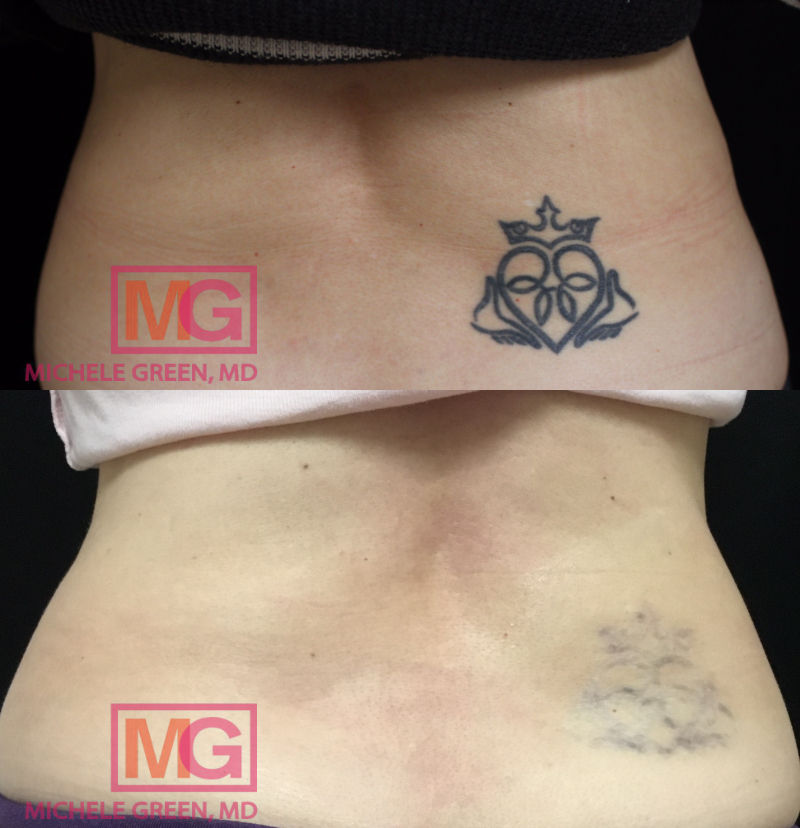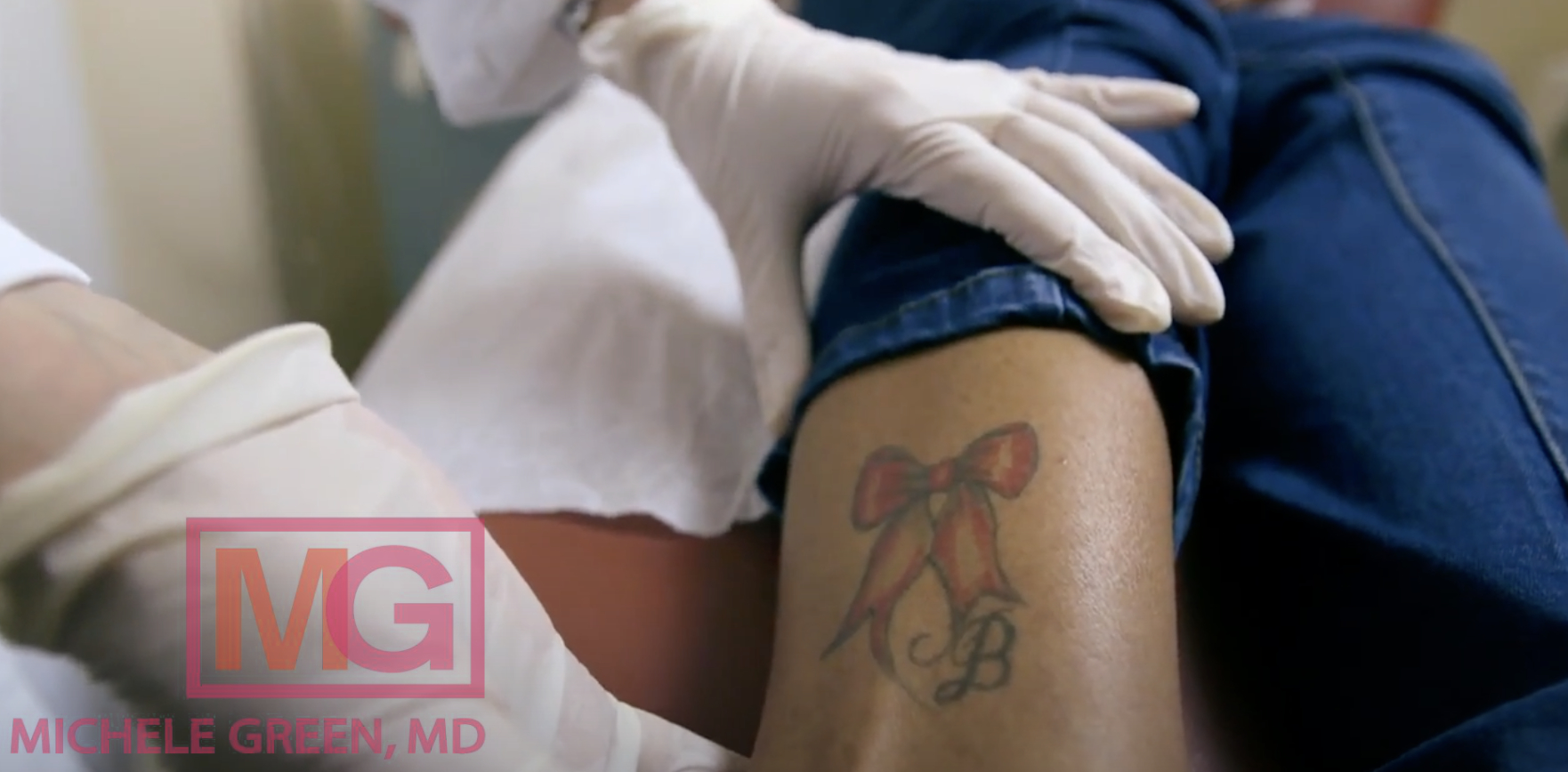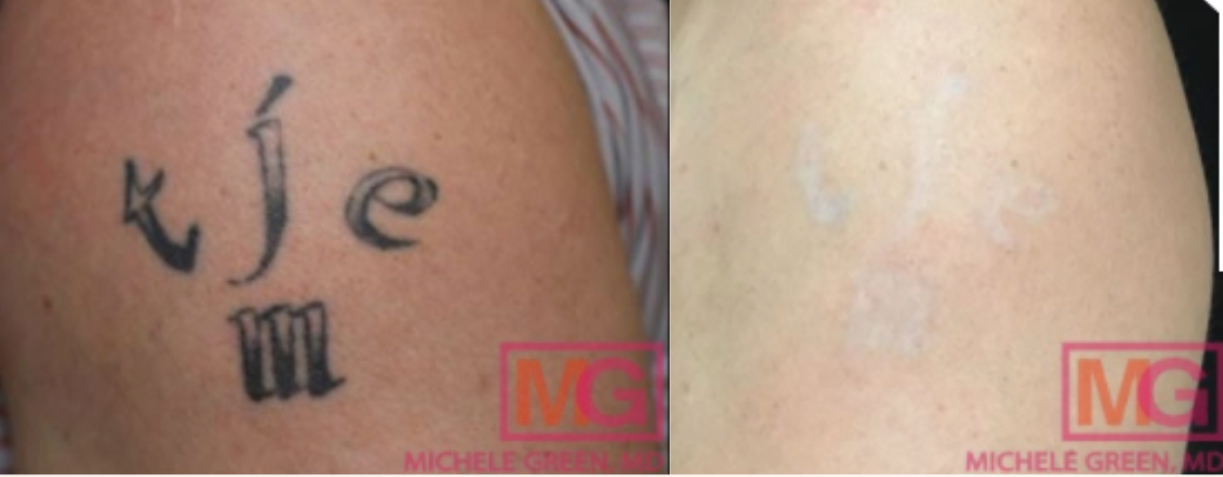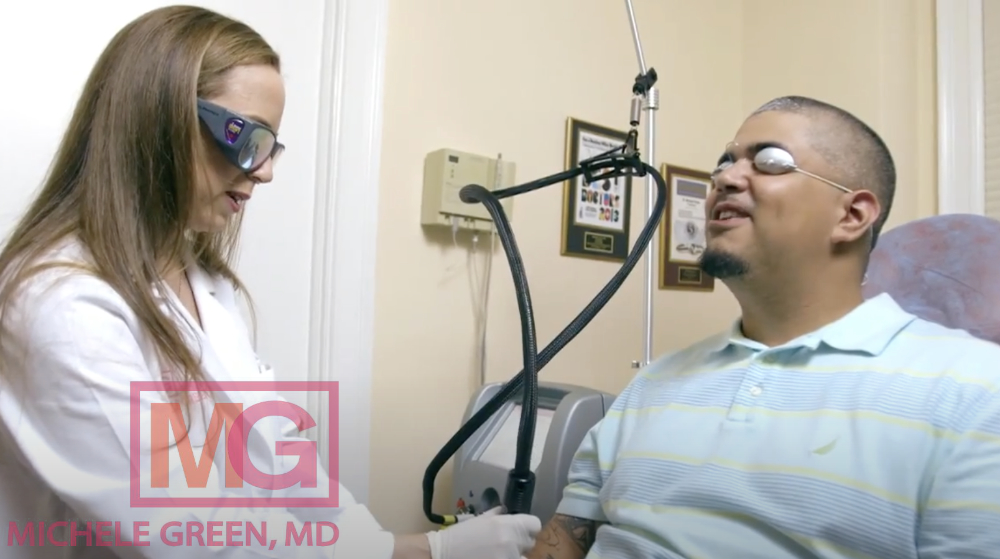Does Tattoo Removal Hurt?
Tattoos are becoming increasingly common in the United States, as nearly 30% of all Americans and almost half of all millennials have them. For many people, original tattoos can serve as a symbol of self-expression, a representation of a significant memory or relationship, or simply an aesthetically pleasing design. Others, however, may have second thoughts and regrets after receiving lettering, symbols, or art that will be present on your body for the rest of your life. Fortunately, if you are experiencing tattoo regret, several options are available for tattoo removal, and one of the most effective is laser tattoo removal. To access FDA-approved, safe, and effective tattoo pigment removal, schedule your initial consultation with expert board-certified dermatologist Dr. Michele Green at her Upper East Side, New York City dermatology office.
Laser tattoo removal is a safe and effective option for removing visible pigment, associated with minimal discomfort and no downtime. Patients often wonder if laser tattoo removal is painful, and the answer depends on several factors, including the size, pigment, location, and age of the tattoo, as well as the patient’s pain tolerance. Dr. Green has several options available to reduce the risk of discomfort, including a topical numbing cream that can be applied before the treatment begins. To find out what type of treatment is best for your tattoo removal journey, schedule your initial consultation with experienced board-certified dermatologist Dr. Michele Green.
Dr. Michele Green is a world-class expert in cosmetic dermatology and laser tattoo removal. She has been safely and effectively removing black and colored tattoo ink from patients of all different skin tones using laser treatments and dermabrasion in her Upper East Side, New York office for over 25 years. Dr. Green offers the most cutting-edge laser treatments to remove unwanted tattoos, regardless of their size and color. During your consultation, Dr. Michele Green will discuss the process of tattoo removal, the number of treatments required, and the best laser technology for your specific needs. Well-known for high patient satisfaction and often praised in patient testimonials, Dr. Green has been voted one of the best dermatologists in New York City by such publications as Castle Connolly, New York Magazine, and Super Doctors.
What is laser tattoo removal?
Laser tattoo removal treatment is a safe and effective way to eliminate an unwanted tattoo with minimal discomfort and downtime. The treatment utilizes laser technology to break down the pigmentation in the deep layers of the tattooed skin, allowing your immune system to metabolize the pigment and reduce the appearance of the tattoo. By triggering the body’s metabolic processes, laser treatments are a less invasive tattoo removal method compared to tattoo removal creams. For optimal results, patients will require a series of treatment sessions to remove the tattoo completely. Patients will consult with expert dermatologist Dr. Green to create a treatment plan that best suits their aesthetic goals.

How laser tattoo removal works
Modern laser tattoo removal is the most effective method for removing tattoo pigment without damaging the surrounding skin. When tattoos are created, the ink is placed deep into the dermis, the layer of skin located below the outer layer. Your body’s natural immune system sends white blood cells to the area to filter as many ink particles as possible. Larger ink particles that the white blood cells are unable to break down are left behind, leaving the tattoo design on your skin. Over time, the white blood cells break down the leftover larger particles, leading to the natural fading of the tattoo ink. This means that your immune system is constantly trying to eliminate the tattoo ink, as if it were a foreign body in the skin that does not belong there naturally.
Laser tattoo removal takes into account the fact that your immune system is actively trying to eliminate the tattoo ink. In laser tattoo removal, the laser system breaks up the pigments in the tattoo ink, layer by layer, with a high-intensity light beam. The pigment breaks down into microparticles, which are then carried out by white blood cells via phagocytosis and eliminated from the body through the liver. Laser tattoo removal works based on the principle of selective photothermolysis. This means that the darker the tattoo ink color, the more wavelength is absorbed by the laser, and the easier the ink gets destroyed. Because black pigment absorbs all laser wavelengths, it is the easiest color to treat. Colored pigments can be treated with specific lasers at different wavelengths, depending on the specific color of the pigment. The laser tattoo removal process removes tattoo ink from the skin, revealing the clear, natural skin underneath.
What are the side effects of laser tattoo removal?
Laser tattoo removal works to eliminate the pigmentation of tattoos in the skin while leaving the surrounding tissue unharmed. Generally, the side effects of laser tattoo removal are mild and typically resolve within a week after treatment. These mild side effects include redness, swelling, bruising, and blistering in the treated area, though blistering can worsen if patients pick at the scabbing skin. In very rare cases, some patients may experience additional scarring or hyperpigmentation at the treatment site as a result of laser tattoo removal. The risk of developing serious side effects is significantly reduced when seeking treatment from an expert medical professional, such as a board-certified dermatologist like Dr. Green.

Does tattoo removal hurt?
Patients often wonder about the pain of tattoo removal, asking whether the tattoo removal journey is painful or pain-free. While patients may experience some discomfort during and immediately after the laser tattoo removal appointment, Dr. Green offers various options for pain management. Before the laser removal appointment, Dr. Green will apply a local anesthetic topical numbing cream, usually lidocaine, which numbs the top layer of skin to reduce the risk of pain during treatment. Following the treatment, Dr. Green may recommend applying an ice pack to the treated area to reduce discomfort further. Dr. Green cautions patients not to take blood thinners, such as ibuprofen, before the procedure, as they can increase the risk of bruising, swelling, and redness after the procedure.
What is the aftercare to reduce tattoo removal pain?
Laser tattoo removal is a safe and effective treatment that causes minimal discomfort and has a short recovery period. Some patients may experience mild, common side effects, including redness, swelling, bruising, blistering, and scabbing, but these effects should subside on their own within a week. After each subsequent treatment, common side effects should diminish in severity. Following the procedure, patients can resume their regular activities but should be advised to keep the treatment area wrapped in gauze and bandaged for three days. Strict sun avoidance is also recommended to protect the treatment area, which will be more susceptible to photodamage throughout the treatment process. When discussing your treatment plan, Dr. Green’s office will also provide comprehensive aftercare instructions.
Laser tattoo removal FAQs
How painful is it to remove a tattoo?
Patients often ask, “How much does tattoo removal hurt?” The level of pain during tattoo removal depends on several factors, including the size, color, and location of your tattoo, as well as a person’s pain tolerance. The age of the tattoo and the type of ink used also influence how much discomfort you will feel during the procedure. Older tattoos tend to be more faded, which usually results in less pain and fewer treatment sessions needed for complete removal. Dr. Green always applies a topical anesthetic cream to the area one hour before the procedure to reduce discomfort. Additionally, Dr. Green may inject lidocaine into the area to ensure the treatment is not painful.
What does laser tattoo removal feel like?
Any pain associated with laser tattoo removal is typically minor and usually fades within a couple of hours. Some patients compare the sensation of laser removal to a rubber band snapping on the skin’s surface, resulting in a sharp, stinging sensation that fades over time. Others say that laser removal can cause the skin to feel as though it has had a sunburn, characterized by a warm, mild burning sensation. Others describe it as feeling like a bee sting or a small electric shock. Before the treatment begins, Dr. Green will apply lidocaine, a topical numbing cream, to the treatment area to minimize discomfort during the procedure.

Why does tattoo removal hurt?
Patients often ask, “Why is tattoo removal so painful?” Laser tattoo removal is not typically associated with significant pain. In fact, most patients report only minimal discomfort during the treatment itself, saying that the pass of the laser feels like a rubber band snapping on the skin. Following treatment, patients may experience a sensation of hot, red skin, similar to a sunburn. Laser removal treatments emit beams of laser energy that are converted into heat in the inner layer of the skin, destroying the pigment there while leaving the surrounding skin largely unaffected. The heat in the dermal layer of the skin is responsible for the slight redness and sunburn-like feeling that follows the treatment.
Where does a tattoo hurt the least?
Tattoos on certain areas of the body are more painful to remove than others, and the same principle applies to tattoo removal. Typically, the areas of the body that hurt the most when getting a tattoo and during laser tattoo removal are those where the skin is closer to the bone and there are more nerve endings, such as the fingertips, rib cage, ankles, feet, head, wrists, and armpits. Tattoos tend to hurt less in areas with more muscle mass or fat, including the thighs, upper arms, and calves. Small tattoos tend to involve less discomfort, as the treatment takes a much shorter amount of time —typically a couple of minutes —compared to larger tattoos, which can take up to twenty minutes per session.
Is tattoo removal more painful than getting a tattoo?
Tattoo removal is a safe and effective option for eliminating unwanted tattoos with minimal pain and no downtime required. Most patients find that the discomfort associated with tattoo removal is much less than the pain associated with getting the tattoo in the first place. The amount of pain associated with tattoo removal depends on several factors, including the location, size, and age of the tattoo.
How sore is laser tattoo removal?
Most patients agree that laser tattoo removal is only mildly painful or uncomfortable. The procedure can cause slight discomfort where the laser is applied to the skin; however, before undergoing the laser treatment, Dr. Green’s office will apply a topical numbing cream to minimize potential discomfort. In the days following treatment, patients may experience swelling, redness, and some blistering. It is best to care for the treatment area by keeping it moisturized with Aquaphor or Vaseline to minimize discomfort during the healing process.
What helps with tattoo removal?
At Dr. Green’s Upper East Side office in New York City, several options are available to help manage pain during the tattoo removal process. Rather than using tattoo removal creams, Dr. Green most often turns to laser tattoo removal treatment. Before the laser procedure, Dr. Green will apply a topical numbing cream to minimize discomfort during the procedure. Following the laser treatment, Dr. Green will provide instructions on how to ice the treated area to reduce swelling and irritation. Before and after the procedure, wearing sunscreen with an SPF of 30 or higher is essential to keep the skin looking healthy and to enhance the treatment results.

Where to remove tattoos? How to get started with tattoo removal today
Tattoo regret affects one in four tattooed people, and laser tattoo removal treatment is a safe and effective way to eliminate an unwanted tattoo with minimal discomfort and downtime. The treatment utilizes laser technology to break down the pigmentation in the deep layers of the skin, allowing your immune system to metabolize the pigment and reduce the appearance of the tattoo. By triggering the body’s metabolic processes, laser tattoo removal is a less invasive method than older tattoo removal techniques, yet equally effective. For optimal results, patients will require a series of treatment sessions to remove the tattoo completely. Patients will consult with expert dermatologist Dr. Green to create a personalized treatment plan tailored to their aesthetic goals.
Dr. Michele Green is an internationally renowned board-certified dermatologist with over two and a half decades of experience providing her patients with the best non-invasive treatment options. Dr. Green takes a holistic approach, embracing a less-is-more philosophy, and creates customized skincare routines and treatment plans that cater to the unique concerns and aesthetic goals of her patients. She is consistently identified as one of New York’s best dermatologists by Castle Connolly, New York Magazine, and Super Doctors for her dedication to her patients and expertise. Please call us at 212-535-3088 or email our New York City-based office today to schedule a consultation with Dr. Michele Green and find out if laser tattoo removal is the best option for you.
 212-535-3088
212-535-3088